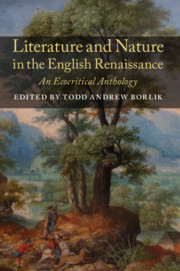Book contents
- Frontmatter
- Contents
- List of Illustrations
- Acknowledgements
- Editorial Principles: Towards the Ecocritical Editing of Renaissance Texts
- Introduction
- PART I Cosmologies
- PART II The Tangled Chain
- Hierarchy and the Human Animal
- Beasts
- Birds
- Fish
- Insects
- Plants
- Gems, Metals, Elements, Atoms
- PART III Time and Place
- PART IV Interactions
- PART V Environmental Problems in Early Modern England
- PART VI Disaster and Resilience in the Little Ice Age
- Appendix A Industrialization and Environmental Legislation in the Early Anthropocene: A Timeline
- Appendix B Further Reading: A Bibliography of Environmental Scholarship on the English Renaissance
Gems, Metals, Elements, Atoms
from PART II - The Tangled Chain
Published online by Cambridge University Press: 05 June 2019
- Frontmatter
- Contents
- List of Illustrations
- Acknowledgements
- Editorial Principles: Towards the Ecocritical Editing of Renaissance Texts
- Introduction
- PART I Cosmologies
- PART II The Tangled Chain
- Hierarchy and the Human Animal
- Beasts
- Birds
- Fish
- Insects
- Plants
- Gems, Metals, Elements, Atoms
- PART III Time and Place
- PART IV Interactions
- PART V Environmental Problems in Early Modern England
- PART VI Disaster and Resilience in the Little Ice Age
- Appendix A Industrialization and Environmental Legislation in the Early Anthropocene: A Timeline
- Appendix B Further Reading: A Bibliography of Environmental Scholarship on the English Renaissance
Summary
Despite being the first work in English to label itself “natural history,” Maplet's Green Forest is a fantastic compendium of residual medieval beliefs in the occult qualities of metals, stones, plants, and animals. Like many Tudor texts that seek to impose order on the natural world, it adheres to a taxonomy based on human- centred valuations of degree or rank. In the section devoted to minerals and stones, Maplet divides them into three varieties: base, common, and precious. The last of these three were known as gems and endowed with magical properties. The nickname he gives to even the base variety, “hurtfoot,” hints at the fact that Elizabethans did not regard stones and minerals as entirely inert, but as living creatures with a “vegetable soul,” although this was already being denied in France when Maplet's book appeared.
Source: A Green Forest (1567) 1v–2r, 4v–5v, 8r, 9v–10r, 16r, 18r–19r.
Of Amethyst
The Amethyst also groweth in India. It is Prince among those Gems that be Purple-coloured … His force [2r] or virtue availeth against drunkenness. It keepeth a man waking, and driveth away ill cogitations and thoughts, [and] sharpeneth the understanding …
[4v] Of Coral
The Coral groweth in the Red Sea, and so long as it is and hath his being in the waters, it is a kind of Wood. But by and by after that it is taken forth of the water and cometh into the air … it hardeneth and becometh a stone. … Isidore … reports that it resisteth lightnings ° … [5r] They say that it is of power to rid us from all devilish dreams and peevish fantasies …
[5v] Of the Diamond
The Diamond is one of those that be counted something precious. It is in colour almost Crystal-like, but somewhat more resplendishing, and is as good (if it be of any bigness) as a looking glass. Jorach ° calleth it another eye, such certainty and truth giveth it in things done in his presence …
[6v] Of Echites°
Echites is a stone both of India and Persia … It is in colour violet-like. And there is a pair of them, male and female, and be most commonly found both together in the Eagle's nest, without the which the Eagle cannot bring forth her young …
- Type
- Chapter
- Information
- Literature and Nature in the English RenaissanceAn Ecocritical Anthology, pp. 198 - 204Publisher: Cambridge University PressPrint publication year: 2019



